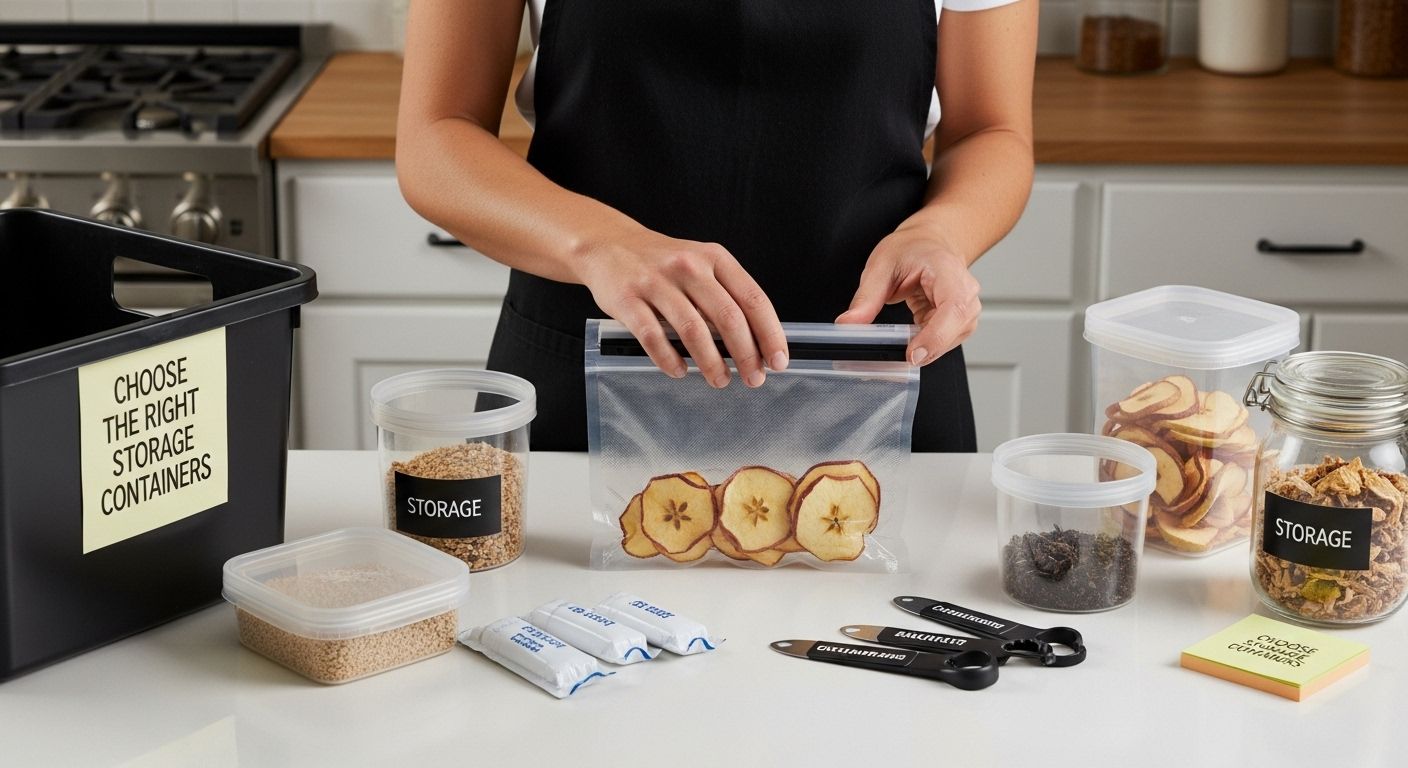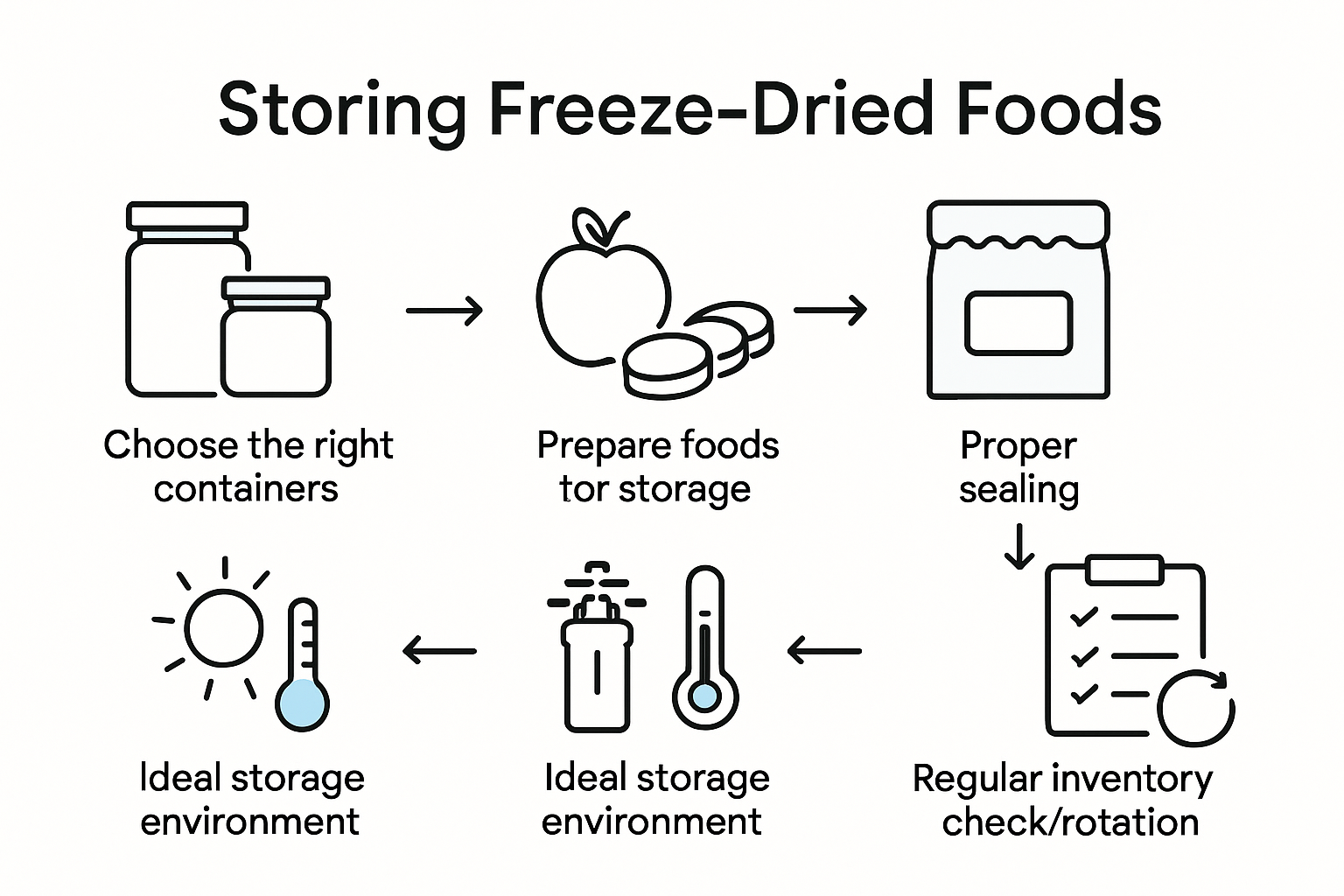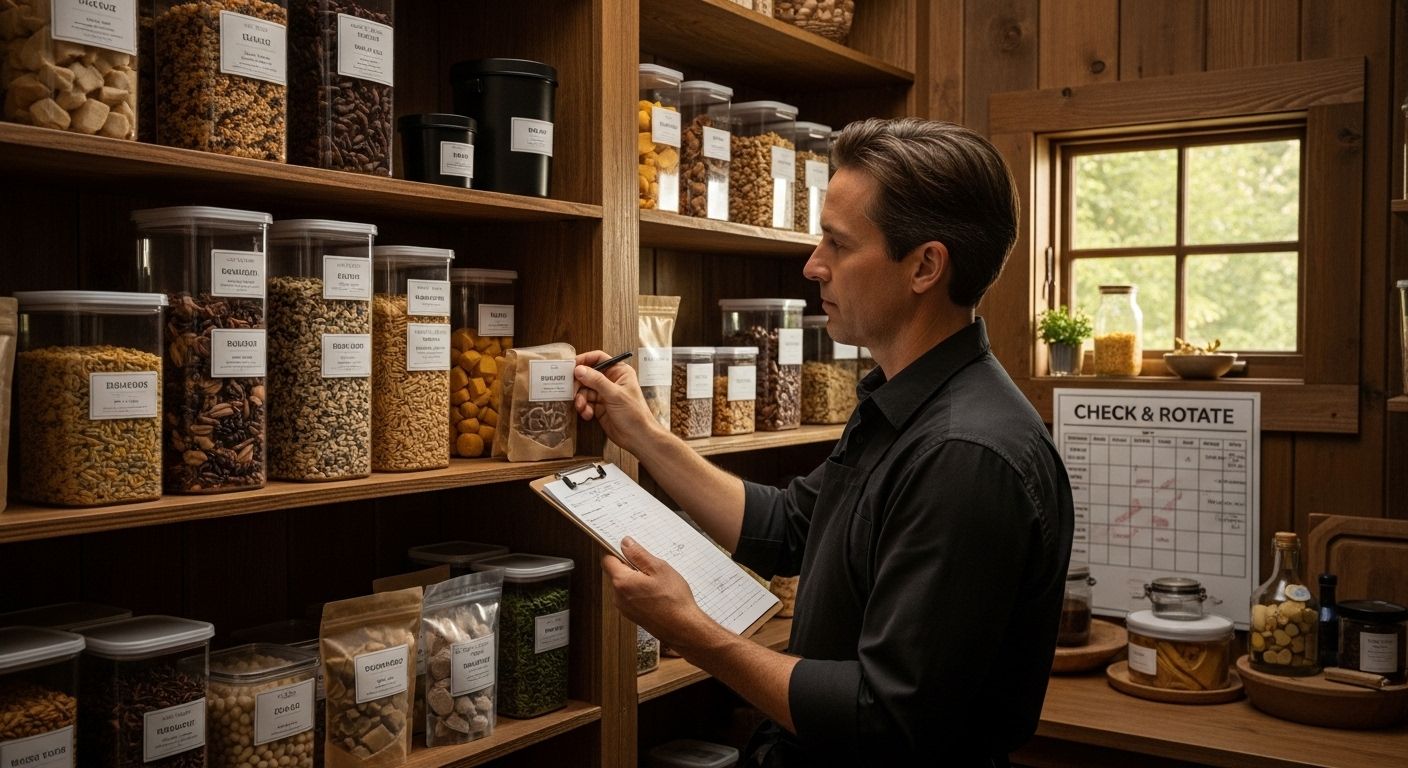
Storing freeze dried food the right way makes a huge difference. Freeze dried foods can stay safe to eat for up to 25 years if handled properly. Most people think tossing them in any container will work just fine. Think again. The smallest bit of moisture or a weak seal could ruin your entire stash faster than you expect.
Table of Contents
- Step 1: Choose The Right Storage Containers
- Step 2: Prepare Your Freeze Dried Food For Storage
- Step 3: Sealing Containers Properly For Freshness
- Step 4: Label Containers With Dates And Contents
- Step 5: Store Containers In The Ideal Environment
- Step 6: Check And Rotate Your Food Inventory Regularly
To summarize the main steps for optimal freeze dried food storage, the table below provides a quick overview including the purpose of each step and a sample verification item.
| Step | Purpose | Key Verification |
|---|---|---|
| 1. Choose storage containers | Protect against moisture, oxygen, light, temp. | Select food-grade, airtight options |
| 2. Prepare foods for storage | Prevent contamination/moisture reabsorption | Clean workspace, inspect foods |
| 3. Seal properly | Lock out air and moisture, extend shelf life | Check seal and use oxygen absorbers if needed |
| 4. Label clearly | Enable tracking of contents and storage duration | Use date, food type, and weatherproof labels |
| 5. Store in ideal environment | Prevent spoilage from heat/light/humidity | Keep storage cool, dry, and dark |
| 6. Check/rotate inventory | Maintain freshness and quality | Inspect and rotate on a scheduled basis |
Quick Summary
| Key Point | Explanation |
|---|---|
| 1. Choose airtight, food-grade containers | Ensure storage containers are airtight and made from food-safe materials to protect freeze dried foods from moisture and oxygen. |
| 2. Prepare foods in a dry environment | Work in a clean, cool space to prevent moisture from reabsorbing into freeze dried foods, which can lead to spoilage. |
| 3. Vacuum seal for maximum freshness | Use a vacuum sealer to remove air from bags and containers, which significantly extends the shelf life of freeze dried foods. |
| 4. Label containers clearly with dates | Include detailed labels on all containers to easily track the contents, seal dates, and monitor freshness over time. |
| 5. Regularly check and rotate inventory | Conduct inventory checks every few months to ensure quality, using the oldest items first to maintain freshness. |

Step 1: Choose the Right Storage Containers
Successful long-term storage of freeze dried foods begins with selecting the perfect containers. The right storage solution protects your food from moisture, oxygen, light, and temperature fluctuations that can compromise quality and nutritional value. Your container choice is the first line of defense in preserving freeze dried foods.
To help you quickly gather the materials you need for optimal freeze dried food storage, heres a table summarizing recommended containers and tools and their specific purposes.
| Tool/Material | Specification/Type | Purpose |
|---|---|---|
| Glass mason jars | Food-grade, clear sides, tight-fitting lids | Airtight storage, easy food inspection |
| Vacuum-sealed bags | Multi-layer, thick, food-safe plastic | Removes air, extends shelf life |
| Food storage containers | Food-grade plastic, tight lids (can be clear-sided) | Bulk storage with robust protection |
| Oxygen absorbers | Food-safe, appropriate size for container | Removes residual oxygen to prevent spoilage |
| Mylar bags (optional) | Opaque, food-grade | Adds extra protection from light and moisture |
| Permanent/waterproof labels | Moisture-resistant, adhesive | For content/ date tracking on containers |
| Hygrometer | Battery operated, digital or analog | Monitors humidity in storage area |
| Silica gel packets/dehumidifier | Non-toxic, food-safe packets or electric dehumidifier | Keeps storage area dry, controls humidity |
When selecting storage containers, prioritize food-grade materials that create an airtight seal. Glass mason jars, vacuum-sealed bags, and specialized food storage containers with tight-fitting lids are your best options. Avoid repurposing containers from non-food sources like paint cans or industrial packaging, which can introduce harmful chemicals or contaminants to your precious freeze dried foods.
Vacuum-sealed bags offer an exceptional storage solution for freeze dried items. These specialized bags remove air completely, dramatically extending the shelf life of your foods. When using vacuum-sealed bags, ensure you select high-quality, thick plastic varieties designed specifically for long-term food storage. Look for bags with multiple layers that provide robust protection against moisture and oxygen penetration.
For those storing larger quantities, consider investing in food-grade plastic containers with oxygen absorbers. These containers provide an extra layer of protection, helping to maintain the integrity of your freeze dried foods. Pro tip: Choose containers with clear sides that allow you to inspect your food without opening the seal. This helps you monitor the condition of your stored items and quickly identify any potential issues like moisture buildup or unexpected color changes.
Moisture is the primary enemy of freeze dried foods, so select containers with exceptional sealing capabilities. Run your fingers along the container’s rim, checking for any imperfections that might compromise the seal. When in doubt, perform a simple water test by filling the container and checking for any leaks before using it for food storage.
By carefully selecting the right storage containers, you set the foundation for maintaining the quality, flavor, and nutritional value of your freeze dried foods for months or even years to come. According to Penn State Extension, proper packaging can significantly extend the shelf life of freeze dried products when combined with appropriate storage conditions.
Step 2: Prepare Your Freeze Dried Food for Storage
Preparing freeze dried foods for storage is a critical step that determines the longevity and quality of your preserved items. Proper preparation prevents moisture reabsorption and potential contamination, ensuring your foods remain safe and delicious for extended periods. This step requires careful attention to detail and a systematic approach to handling your freeze dried products.
Heres a checklist table to help you verify that you are following the correct procedures for preparing freeze dried food for storage. Use it to ensure no critical step is missed.
| Preparation Step | Verification/Tip | Completed (Y/N) |
|---|---|---|
| Clean/sanitize workspace and utensils | Wipe surfaces with food-safe disinfectant | |
| Wash and dry hands | Use soap and warm water before handling food | |
| Work in cool, dry environment | Avoid humidity and sunlight | |
| Inspect freeze dried foods for issues | Look for discoloration, odors, or damp spots | |
| Break apart clumped pieces | Ensure uniform texture, avoid moisture pockets | |
| Separate foods with varying moisture | Create different batches for fruits, veggies, etc. | |
| Wear food-safe gloves (optional) | Minimizes direct contact/contamination | |
| Allow foods to reach room temperature | Prevents condensation in sealed containers |
Begin by creating a clean, sanitized workspace. Wash your hands thoroughly with soap and warm water, and wipe down all surfaces with a food-safe disinfectant. Select a cool, dry area away from direct sunlight and heat sources. Temperature stability is crucial in maintaining the integrity of freeze dried foods. Avoid handling foods in humid environments, as moisture is the primary enemy of long-term food preservation.
Inspect each batch of freeze dried food carefully before storage. Look for any signs of discoloration, unusual odors, or moisture spots that might indicate compromised quality. Gently break apart any clumped pieces, ensuring uniform texture and preventing potential moisture pockets from forming. If you notice any inconsistencies, set those items aside for immediate consumption rather than long-term storage.
For foods with varying moisture levels, consider creating separate storage batches. Fruits and vegetables with different water contents should be packaged individually to maintain optimal preservation conditions. Use clean, dry utensils when handling freeze dried foods to prevent introducing external moisture or contaminants. Wear food-safe gloves if possible to minimize direct contact and potential contamination.
Before final packaging, allow freeze dried foods to reach room temperature. Condensation can form when cold foods are immediately sealed in storage containers, potentially compromising their preservation. Give your foods time to stabilize and reach ambient temperature, which helps ensure a completely dry environment for storage.
According to Penn State Extension, proper preparation is key to maintaining the quality and safety of freeze dried foods. By following these meticulous steps, you create an ideal foundation for long-term food storage that preserves nutritional value and taste.
Step 3: Sealing Containers Properly for Freshness
Sealing freeze dried foods is the critical barrier between your preserved items and potential contamination. Proper sealing determines the longevity and quality of your stored foods, making this step absolutely essential in the preservation process. The goal is to create an airtight environment that locks out moisture, oxygen, and potential contaminants.
Vacuum sealing offers the most reliable method for protecting freeze dried foods. Invest in a quality vacuum sealer designed specifically for food storage. When using this technique, carefully place your freeze dried foods into vacuum-seal bags, leaving enough space at the top for a proper seal. Run your fingers along the bag’s edge to ensure no food particles interfere with the sealing process. Compress the bag gently to remove as much air as possible before final sealing.
For those using glass jars or plastic containers, the sealing process requires equal precision. Inspect the container’s rim carefully, checking for any chips, cracks, or imperfections that might compromise the seal. Wipe the rim clean with a dry, lint-free cloth to remove any food particles or moisture. If using oxygen absorbers, place them carefully inside the container before sealing. These small packets work wonders in removing residual oxygen that could degrade your freeze dried foods.
Tight-fitting lids are your best defense against moisture and air infiltration. Apply gentle pressure when closing containers, listening for the subtle click that indicates a complete seal. For mason jars, ensure the rubber gasket is clean and intact. Pro tip: Gently tap the lid after sealing to check for any potential air pockets or incomplete seals. A properly sealed container should feel firm and show no signs of give when pressed.
For long-term storage, consider double-protection methods. After initial sealing, you can add an extra layer of protection by placing sealed containers in mylar bags with additional oxygen absorbers. This multi-layered approach provides maximum defense against environmental factors that could compromise your freeze dried foods.
Always label your containers with the date of sealing and contents. This simple step helps you track storage time and rotate your stock effectively. According to Penn State Extension, proper sealing can extend the shelf life of freeze dried foods significantly, turning your preservation efforts into a long-lasting food storage solution.
Step 4: Label Containers with Dates and Contents
Labeling is the unsung hero of effective food storage, transforming your freeze dried food preservation from a guessing game to a precise system. Proper labeling ensures you can track the age, contents, and condition of your stored foods with absolute confidence. This step is more than just writing a few words on a container it is creating a comprehensive tracking method for your food storage strategy.
Choose high-quality, moisture-resistant labels that adhere well to your chosen storage containers. Permanent markers work excellently on glass and certain plastics, providing a durable solution for recording critical information. Write clearly and legibly, using a consistent format that captures essential details at a glance. Your label should include the specific food item, the date of freeze drying, and the date of sealing.
Create a standardized labeling system that works across all your storage containers. For instance, use a format like “Strawberries - Freeze Dried - 04/15/2024 - Sealed 04/20/2024”. This approach provides immediate context about the food’s origin, processing date, and storage timeline. Consider color-coding labels for different food categories or using different label styles for various storage methods to enhance visual organization.
Do not rely solely on permanent markers. For vacuum-sealed bags and containers that might experience moisture or temperature fluctuations, invest in weatherproof labels or label makers designed for food storage. These specialized labels resist fading, peeling, and smudging, ensuring your critical information remains readable throughout the storage period.
Maintain a separate log or spreadsheet that mirrors your physical labels. This digital backup provides an additional layer of tracking and helps you monitor your freeze dried food inventory. Include details like the quantity stored, potential expiration estimates, and any specific storage conditions. This systematic approach transforms your food storage from a simple preservation method to a well-managed preservation system.
Regularly review and update your labels during periodic food storage checks. Over time, labels can fade or become damaged, so plan to inspect and potentially replace them during your routine storage maintenance. According to National Center for Home Food Preservation, consistent and accurate labeling is crucial for maintaining the quality and safety of preserved foods.
Step 5: Store Containers in the Ideal Environment
Creating the perfect storage environment is the final crucial step in preserving the quality of your freeze dried foods. Temperature and humidity are the two most critical factors that can make or break your long-term food storage strategy. Your goal is to create a stable, controlled environment that protects your carefully preserved foods from environmental degradation.
Identify a storage location that maintains a consistent temperature between 50 and 70 degrees Fahrenheit. Avoid areas with significant temperature fluctuations, such as garages, attics, or spaces near heating and cooling vents. Basements can be ideal, provided they are dry and free from moisture issues. Kitchen pantries or dedicated food storage closets often provide the most stable environment for your freeze dried foods.
Humidity is the silent destroyer of preserved foods. Aim to maintain relative humidity below 15 percent in your storage area. Invest in a small dehumidifier or silica gel packets to control moisture levels. Place a hygrometer in your storage space to monitor humidity continuously. If you notice any signs of moisture buildup, take immediate action to dry out the area and protect your stored foods.
Light exposure can degrade the quality of freeze dried foods, breaking down nutrients and potentially altering their flavor. Choose a dark storage location or use opaque storage containers that block light completely. If your storage area has windows, consider covering them or using blackout curtains during peak sunlight hours. Think of your storage space as a protective vault designed to shield your foods from environmental threats.
Create a dedicated storage zone that is easily accessible but protected from potential contaminants. Keep the area clean and free from pest activity. Regularly inspect your storage space, checking for any signs of moisture, temperature changes, or potential pest intrusion. Implement a rotation system that allows you to use older stored foods first, ensuring nothing sits untouched for extended periods.
According to Purdue University research, maintaining precise environmental conditions is crucial for preserving the quality and safety of dried foods. By creating a carefully controlled storage environment, you maximize the longevity and nutritional value of your freeze dried food collection.
Step 6: Check and Rotate Your Food Inventory Regularly
Regular inventory checks are the heartbeat of successful long-term food storage. Consistent monitoring transforms your freeze dried food collection from a static stockpile into a dynamic, well-managed resource. This critical step ensures your preserved foods remain safe, nutritious, and ready for consumption when you need them most.

Establish a systematic inspection schedule, ideally conducting thorough inventory checks every three to six months. Choose a consistent date that is easy to remember, such as the first day of a new season or a specific holiday. During these checks, carefully remove each container from storage, examining them for any signs of compromise. Look for subtle indicators like condensation, discoloration, or unusual odors that might suggest potential quality degradation.
Implement a first-in-first-out (FIFO) rotation strategy to maximize the freshness of your freeze dried foods. This means consuming or using the oldest stored items first, gradually replacing them with newer batches. Create a simple tracking system using your labels and inventory log. Mark the date of initial storage on each container and arrange your storage space so that older items are most accessible. This approach prevents any foods from sitting unused for extended periods and ensures you are constantly cycling through your inventory.
Keep a detailed inventory spreadsheet or digital log that tracks each container’s contents, storage date, and potential expiration timeline. Include columns for visual inspection notes, ensuring you document any changes or potential concerns during your regular checks. This systematic approach allows you to quickly identify and address any emerging issues before they compromise your entire food storage collection.
During your inventory rotation, take the opportunity to assess your overall storage environment. Check for any changes in temperature, humidity, or potential pest activity that might have occurred since your last inspection. Adjust your storage conditions if necessary, and replace any oxygen absorbers or desiccant packets that show signs of moisture saturation.
According to the National Center for Home Food Processing and Preservation, regular monitoring is essential for maintaining the safety and quality of preserved foods. By treating your freeze dried food inventory as a living, dynamic collection, you ensure maximum longevity and nutritional value.
Ready to Protect Your Freeze Dried Foods with Professional Solutions?
You have just learned how essential airtight storage and correct sealing techniques are in preserving the quality and freshness of your freeze dried foods. If you are struggling with moisture control, inconsistent labeling, or finding the right packaging to shield your products from humidity and light, you are not alone. Many food enthusiasts and producers worry about loss of flavor or nutritional value due to improper preparation and storage choices. That is why the right packaging partner makes all the difference for long-term success.

Turn your new knowledge into real results. Let the experts at Space Man Freeze Dried Foods help you secure freshness and safety with industry-grade bagging, packaging, private labeling, and co-packing services. We manufacture and distribute premium freeze dried candy right here in Canada. We also ensure your products are stored and delivered in top condition, according to every best practice you have just learned. Take advantage of our solutions today for your own business or order packaged treats directly from our space-man.ca shop. Start protecting your freeze dried foods now before your next batch is at risk.
Frequently Asked Questions
How do I choose the right storage containers for freeze dried foods?
Select food-grade containers that provide an airtight seal, such as glass mason jars, vacuum-sealed bags, or specialized food storage containers. Ensure they protect against moisture, oxygen, light, and temperature fluctuations.
What is the best way to prepare freeze dried foods for long-term storage?
Create a clean workspace, inspect for contamination, allow foods to reach room temperature, and separate foods with varying moisture levels into different batches. This prevents moisture reabsorption and contamination.
How should I seal containers to ensure the freshness of freeze dried foods?
Vacuum sealing is the most effective method. If using jars or plastic containers, check for imperfections on the rims and ensure the seal is tight. Consider using oxygen absorbers for extra protection against spoilage.
Why is regular inventory checking important for stored freeze dried foods?
Regular checks help you monitor the condition of your food, ensuring optimal freshness and safety. Implementing a first-in-first-out rotation system prevents older items from being overlooked and going stale.

